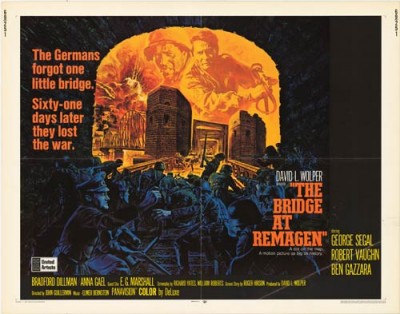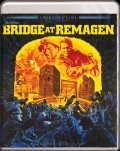| Reviews & Columns |
|
Reviews DVD TV on DVD Blu-ray 4K UHD International DVDs In Theaters Reviews by Studio Video Games Features Collector Series DVDs Easter Egg Database Interviews DVD Talk Radio Feature Articles Columns Anime Talk DVD Savant Horror DVDs The M.O.D. Squad Art House HD Talk Silent DVD
|
DVD Talk Forum |
|
|
| Resources |
|
DVD Price Search Customer Service #'s RCE Info Links |
|
Columns
|
|
|
Bridge at Remagen, The
The Bridge at Remagen (1969) uneasily straddles these conflicting worlds. Partly it's a big-scale epic, partly it's a more cynical, more intimate look at the human cost of warfare. As war movies from that era go, the film is slightly above average in terms of the writing and direction, and because of its ingenuity it looks a lot more expensive than it likely was. But it's not as engrossing as it might have been and while its leading actors deliver good performances, they lack the charisma to keep audiences fully engaged.
The movie was adapted from the same-named non-fiction book by Ken Hechler, who survived the Battle of Remagen and later represented West Virginia's 4th District in Congress. (He died last year at the age of 102.) Adapted by William Roberts and novelist Richard Yates, the movie isn't much concerned with historical accuracy of the battle and, unusual for the time, is instead chiefly interested in just two main characters, with two others of lesser, secondary interest.
In March 1945 the war in Europe is nearly over. The Germans are in full retreat but also anxious to hold the Allied Forces at "the great moat that guards the heart of Germany - the River Rhine." The Germans have destroyed all access across the Rhine save for the Ludendorff Bridge, partly because the 15th Army, some 75,000 German troops, are still retreating from the other side of the river.
In the movie, General von Brock (Peter can Eyck) officially orders old friend Maj. Paul Kreuger (Robert Vaughn) to destroy the bridge while implicitly suggesting that Kreuger hold it for as long as possible to save as many German troops as humanly possible.
Meanwhile, ambitious, upwardly mobile Maj. Barnes (Bradford Dillman) orders his men, primarily Lt. Hartman (George Segal), to spearhead the advance to the bridge at Remagen. Initially they face little resistance from the defeated Germans, and are surprised to discover the bridge still intact, albeit packed to the gills with high explosives. Gen. Shinner ("Guest Star" E.G. Marshall) orders Barnes to order Hartman to take the bridge, a veritable suicide mission, while Kreuger, with few men and little ammunition, attempts to destroy the bridge and defend his position.
The making of The Bridge at Remagen is in some ways more interesting than the film itself. According to Wikipedia, West German official would not allow the production to shoot along the real Rhine because it would impede shipping traffic, and so instead nearly all the film was shot in what was then Czechoslovakia. However, the true reason was probably that it was significantly less expensive and problematic. Further, Czech officials granted permission for the production to essentially destroy the entire village of Most, already slated for demolition to accommodate a planned lignite mining operation. Near the end of shooting the Soviet Army invaded Czechoslovakia, forcing the film crew to flee via a convoy of taxis and trucks.
The production took full advantage of having an entire town to pummel at its leisure, including one particularly incredible shot of several multistory buildings blowing up and collapsing dangerously close to advancing troops and tanks. Spectacular as it is it's also a bit painful to watch all that beautiful architecture crumbling into enormous piles of dust and rubble.
All this, however, is incidental to the main story, which focuses almost exclusively on the battle seen through the eyes of one man from each side: Hartman and Kreuger. Neither character is particularly original, falling in line with the well-written vignettes of The Longest Day: Hartman is war-weary and increasingly disheartened by the human tragedy all around him, but compliant toward a superior officer he knows puts personal ambition ahead of the safety of the men in his charge; while Kreuger, aware that the war is already lost, tries to balance his sense of duty with basic human decency.
Vaughn, the only American in a cast English-speaking Germans (van Eyck, Hans Christian Blech, Gunter Meisner, etc., with Blech playing a part similar to his role in The Battle of the Bulge) is unexpectedly excellent and his character is by far the most interesting. (Amusingly, colleague DVD Savant though Vaughn the weakest part of the movie.) Kreuger knows the war is lost but for reasons of self-preservation can never express his true feelings, even to like-minded Generaloberst von Brock, presumably fearing anyone could report him as a traitor. At a checkpoint Kreuger watches as SS troops execute a fellow German officer. Kreuger's driver expresses dismay that the war has come to this, yet Kreuger dare not commiserate, even with him. Movies about the losing side of a war turning on themselves and in various states of denial and acceptance always make fascinating viewing and these scenes work well here, aided in no small way by Vaughn's reticent screen persona.
Kreuger's counterpart, Hartman, may by on the winning side but is no less torn. Maj. Barnes is clearly a bastard, and though perhaps not the intention of the screenwriters Gen. Shinner comes off as one as well, but Hartman is resigned to obeying their orders, however foolhardy and destructive they may be. Neither Hartman nor Kreuger are the stereotyped "loyal soldier" but, rather, each is compelled to work with what they have, even when their superior officers ask the impossible and impede their own success.
Third-billed Ben Gazzara, as Hartman's right-hand man, Sgt. Angelo, has a less substantial role as an immoral soldier who gleefully robs corpses of their valuables ("Everybody's makin' money off this war," he argues) until he kills a teenage Hitler youth taking potshots at the platoon. Director John Guillermin, who knew his way around big action spectacles, keeps the action taut with a constantly moving camera (including optically sped-up action) and myriad aerial shots to help the audience know the layout.
One wonders if the filmmakers took a bland concept and made it more probing and ambitious, or if maybe they started out with ambitious concepts but hedged their bets, turning The Bridge at Remagen into something more safely conventional. It deserves points for being grittier and slightly more realistic than most ‘60s war movies, but it never quite approaches Samuel Fuller levels of verisimilitude.
Video & Audio
Twilight Time's Blu-ray, licensed from MGM's UA catalog, offers a mostly excellent transfer of this Panavision (2.35:1 widescreen) production. The nature of shooting a combat movie means that the compositions of cinematographer Stanley Cortez are variable, but many are razor sharp and the color is excellent, despite the beginning of one reel exhibiting terrible decomposition for several seconds. My only complaint is that the film's many night scenes (nearly have the film) seem to have been color corrected digitally and made rather too dark and washed out. Audio-wise, the DTS-HD Master Audio (1.0 mono, English only with optional English subtitles) has impressive bass here and there, though I found the sound effects overwhelming the dialogue and found myself constantly adjust the volume. A limited edition of 3,000 units, the disc is region-free.
Extras
Supplements include a trailer, an isolated music track of Elmer Bernstein's score, and Julie Kirgo's usual liner notes.
Parting Thoughts
Impressive on big projection system screens, and better than average script-wise, The Bridge at Remagen is Recommended.
Stuart Galbraith IV is the Kyoto-based film historian largely absent from reviewing these days while he restores a 200-year-old Japanese farmhouse.
|
| Popular Reviews |
| Sponsored Links |
|
|
| Sponsored Links |
|
|
| Release List | Reviews | Shop | Newsletter | Forum | DVD Giveaways | Blu-Ray | Advertise |
|
Copyright 2024 DVDTalk.com All Rights Reserved. Legal Info, Privacy Policy, Terms of Use,
Manage Preferences,
Your Privacy Choices | |||||||















